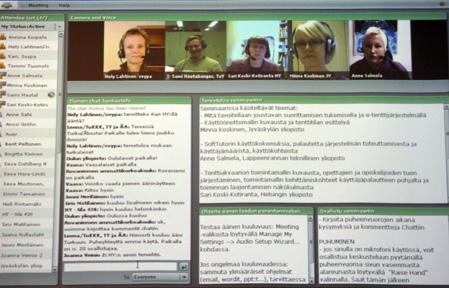
The Finnish Virtual University organized an online seminar on the 9th of December 2009 about taking exams using computers instead of plain ol’ pen & paper. The potential benefits are obvious: students can choose more freely when (and possibly where) to take the exam, and the teacher doesn’t have to worry about finding the suitable time and space to organize an exam. Four speakers from different universities told us about their solutions in this area during a two-hour Adobe Connect Pro meeting, so attending the conference didn’t require a lot of travelling and it worked surprisingly well.
From the presentations it became obvious that there are really two different philosophies of doing exams electronically:
First, there is the more traditional exam type where the student can book a time slot according to his needs, and then go to the space which has been setup as a dedicated exam environment with a computer shut off from the regular internet and a remote surveillance system (usually a video camera and a microphone recording the student). Even staff or students can be around monitoring the process, providing extra security to discourage cheating. These exams can be just like regular exams where you (usually) aren’t allowed any materials and must know all the details by heart.
Second, there is the completely do-it-anywhere-virtual-exam, where the student can use any online computer to take the test, even from the comfort of ones home if he or she so wants. This usually means that cheating cannot be monitored in any secure way and so the exam itself must be of a different type: learning materials are allowed but the questions are broad in scope and require knowledge that you simply haven’t got the time to learn in the time it takes to complete the exam.
The differences between these two ways of thinking about e-tests are interesting and the exam culture probably depends a lot on the subject being taught/learned, so it was interesting to hear about the different approaches chosen.
The aquarium approach
Three universities had built an “electronic aquarium” -type solution, of which two – the University of Jyväskylä (UJ) and Lappeenranta University of Technology (LUT) – had a solution based on the SoftTutor application. LUT had an aquarium in their library building, with 10 machines (seats) and 4 cameras monitoring the place, as well as some paid students on monitoring duty. About 30 teachers are taking advantage of the system at the University, especially for the “maturity test” (fin. kypsyysnäyte, a small exam that tests the student’s knowledge of his/her thesis).
Jyväskylä has a similar solution, with 12 seats and 6 drawing tablets, enabling some sort of free hand drawing to be added to the the exam. 8 courses and 7 teachers were using this electronic exam system as a compliment to the normal exams. The University of Helsinki has a few different approaches to electronic exams, of which the oldest has been the aquarium system called “Tenttiakvaario”, which is currently in use on the Viikki Campus (3 seats) and at the Faculty of Law and Order… awww, ok, just the Faculty of Law (1 seat), so this is a smaller scale solution that students and teachers nevertheless have been happy with.
The more Out-of-the-box approach
At Tampere the University has taken the course management system Moodle and uses its quiz module for making exams, with the goal of having large groups of students taking the exams in a short time period. Electronic exams have been seen as being especially helpful with organizing book exams, that students need to take sporadically. Using existing computer classes especially the summer exams have been popular – during the summer of ’09 927 exams were taken. The exams were monitored, as with the previous examples, using access control cards, video surveillance and spot checks.
At the University of Helsinki Moodle has also been thought of as a way to make remote exams, and then of course the exams themselves have to be re-thought because surveillance is next to impossible to organize. For example, exams then have to be more “putting knowledge in practice”-type broad questions than questions asking for detailed tidbits of knowledge. This approach could in the future mean great savings to space costs if people could do exams on their home computers instead of being dependent on expensive computer classes. And space costs are always an issue in Helsinki.
It was nice to hear these stories, and I think electronic ways of taking exams – or really any new way of grading & monitoring learning – could be helpful, but maybe the biggest challenge then is to embrace the new possibilities instead of trying to fit the old ways into new technology. It is an frustrating idea that you have all that processing power and networked knowledge at your fingertips, but you’re only allowed to write text in a Word document during the exam.
Edit – forgot the music to this post, here it is – a soothing piano piece (no video) by Eluvium, the album Copia is really great!
[youtube http://www.youtube.com/watch?v=_rEkxKhCp40]
Further reading:
The seminar presentations:
http://palvelut.virtuaaliyliopisto.fi/palvelut/seminaarihuone/?q=node/179
Tenttiakvaario at the University of Helsinki:
http://ok.helsinki.fi/tentti/

One Reply to “Electronic exams in the Finnish universities”
Comments are closed.